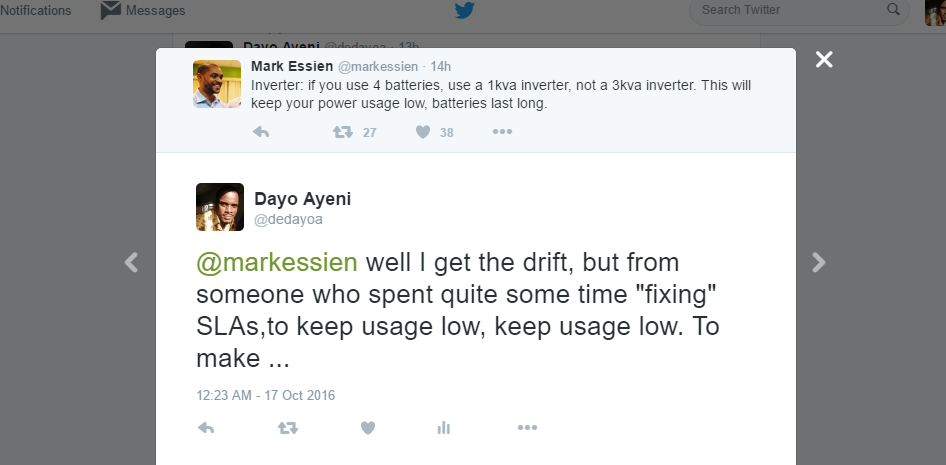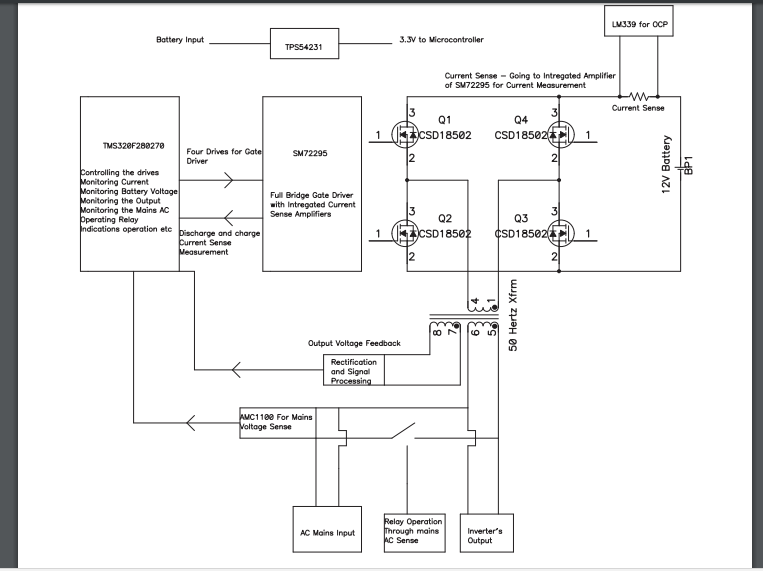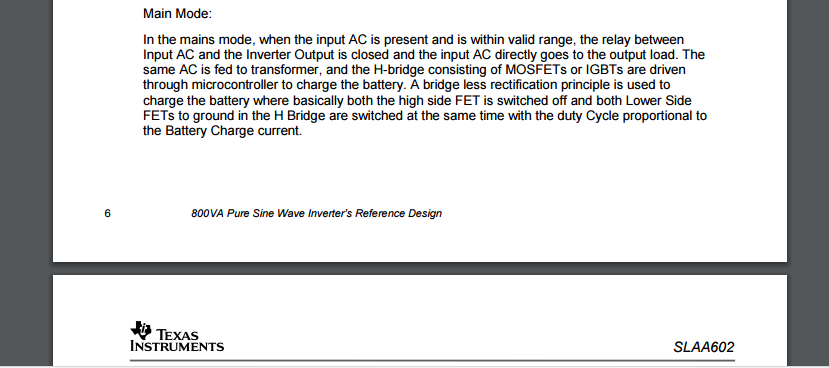Inverter, Batteries, Power Usage, Sealed Lead Acid Battery lifespan
You see, I really didn’t know what to title this post, so I kinda just put together the keywords from the tweet I stumbled upon that tripped my having to put this together.
This particular piece was inspired by a tweet from a friend of a friend…of a friend, @markessein. He’s the man behind hotels.com.ng, that big hotels website – you see I know people who’re doing big things :D. See a screengrab of his tweet below.

The thing is, what Mark’s said is not wrong. With a 1KVa inverter – instead of a 3KVa inverter, the total load you can hook up to the inverter is about 1KW (assuming a Power Factor of 1). So, rather than having your 2 50″ TVs, your PS4, all 16 of your lights bulbs, your 4 laptop PCs and even the washing machine all running at the same time, you probably will be constrained to just 1TV, the PS4 and a few bulbs.
Also, because you have more cells, you can afford a Depth-of-Discharge of about 10-20%. This greatly increases the cycle count (the charge-discharge cycle) of the batteries.
With 4 units of 200Ah batteries (I am assuming he meant 4 batteries in parallel, as you cannot as at today find a home/office Inverter rated 1KVa/48V), you get a total of 9,600Wh. By loading your inverter to 80% of it’s maximum 1KVa, you’d run out of juice at about the 12th hour of constant run.
If on the other hand you have a 3KVa Inverter, and you have loaded it to just 50% of it’s rated maximum, you’d run your battery down in about 6.4 hours; effectively killing your battery faster – as a result of Peukert’s Law.
[Note: Batteries, SLAs especially do not have a linear charge/discharge characteristic. Meaning, I really shouldn’t be straight-dividing the total energy capacity by the load, but for simplicity sake…]
However, there’s just one problem. What he has said is just a fraction of the picture, and by recommending that you use a 1KVa inverter with 4 batteries, you might end up doing more harm than good, and here’s why…
- The Charger.
Most inverters actually have a secondary mode, and this is the Charger/Mains Mode. When that Inverter is “working”, it is converting Direct Current (produced by your batteries) to Alternating Current (required by your applianced). This is a DC-to-AC conversion. This conversion is made possible in the first place, because the batteries were charged. Once you exhaust the charge in the battery, you are left with lots of lead, copper, steel and sand…oh, and “no light”.
So, you need to charge the batteries for the Inverter to be useful again. For most commercial inverters, the way this is done is that the same components, working in reverse, do the charging of the batteries. This is an AC-to-DC conversion, and you do not need a separate charger to charge your batteries.
If you decide to hook up a 1KVa/12V inverter to 4||12V batteries, you surely will enjoy longer run-times, but when the time comes to charge the batteries…
- Will require about 4X the usual time to fully charge your batteries. Now, you get PHCN 6 hours in a day, what’s the guaranty you’ll get public power that long. In effect, your batteries rarely ever get fully charged.
- Will be operating the charger (the Inverter) way out of it’s manufacturer specifications and this will surely void your warranty. The system will have to run longer, sending the equipment galloping towards its MeanTime-to-Failure (MTTF)

- In Practise…
I can imagine that Mark is not saying we all use 1KVa Inverters, but rather we (give and take) use about 4 batteries for every 1KVa; so with 3KVa, you use 12 batteries. In theory, this sounds fantastic. In practise however, there are other considerations that will influence the recommendations of an Inverter system.
In sizing an inverter system, there are certain considerations that have to be factored in, and among these include:
- The expected total load in KiloWatts.
- The type of load e.g resistive, inductive.
- The type of use e.g PV off-grid, PV with PHCN, intermittent backup etc.
- The desired run time.
- The nature of Power Supply in the area.
- Expected lifespan of the battery.
- Budget for the system.
For most users, the most important consideration is run time. However, as implementors, it is our job to factor in, and carefully balance the other aspects, as they are just as equally important.
I believe that it is the user’s expectations/needs that should influence the choice of inverter and battery size, not the other way around. As a matter of fact, in practise, Mark’s recommendation might be the best solution for his use case, however it is by no means the optimum configuration for all use cases.
I had a very long day and I’m starting to doze. My last words are,
Talk to a professional to help you size your Inverter system. Don’t discharge your batteries beyond 50%. Maintain your batteries – especially in this era of 100K batteries.
When learning about batteries, http://batteryuniversity.com/ was really helpful. If you’re interested in learning about batteries, visit the site. You’ll learn a whole lot more than I can put in one post.





You must be logged in to post a comment.